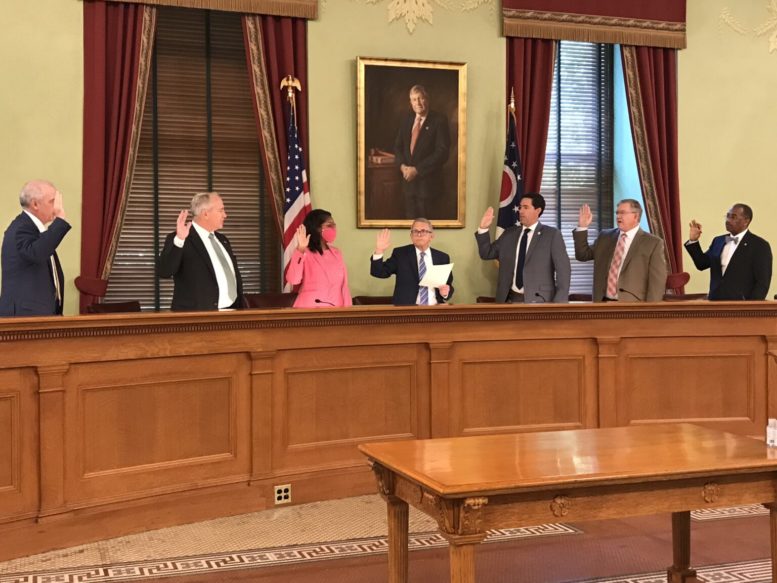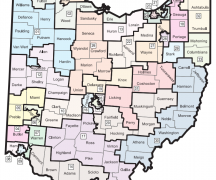BY SUSAN TEBBEN
The Ohio Redistricting Commission had its first meeting Friday without much fanfare, and very little on the agenda, despite a squeezed timeline to get its work done.
Gov. Mike DeWine called the commission, which oversees the redrawing of legislative and Congressional voting districts, to order and announced the appointment of members and transferred the rest of the business to the commission’s co-chairs, House Speaker Bob Cupp and state Sen. Vernon Sykes, D-Akron.
Cupp acknowledged the “tight timeframe” the commission and the legislature has to work with, but said they still plan to hold the constitutionally required public meetings. The dates and times of those public hearings have yet to be decided, Cupp and Sykes said after the commission adjourned.
“We want to hear from them and include them in this matter,” Cupp said.
Cupp said he’s hoping for a bipartisan agreement on the district maps, which would make them effective until the next census in 10 years. If a bipartisan agreement can’t be made, the maps may be approved for four years, meaning the districts will be redrawn again before the next census.
The first deadline to adopt a redistricting plan is September 1 for state legislative districts, and September 30 for Congressional districts. If there is an impasse on the maps, the legislative map deadline can be extended to September 15.
For Congressional district lines, an impasse would result in the commission attempting to adopt a bipartisan plan by October 31. If the commission can’t adopt a plan, the General Assembly gets a shot at it, with a deadline of November 30.
The deadlines were complicated by a delay in receiving the data from the U.S. Census Bureau needed to draw the maps. The Census Bureau recently announced the data would come out a few days earlier than planned, on August 12.
Groups working to get Ohioans engaged in the process say the timeline doesn’t leave a lot of wiggle room, and the fact that nothing was done or scheduled in the first meeting of the commission is not encouraging.
“It’s disappointing that the 18 minutes that we got from this commission just 25 days before our first map deadline and six days before data drops, we got no clear schedule about when they’re going to hear from members of the public about this process,” said Katy Shanahan, of the Equal Districts Coalition and state director of All On the Line Ohio, a group specifically working to end gerrymandering.
***
Also from Ohio Capital Journal:
Mapping team at OU a part of redistricting process
Before the Ohio Redistricting Commission was appointed, before advocacy groups started mobilizing for fair districts, before even the last presidential election, a team at Ohio University was working toward their own map-drawing goals.
Back in 2017, a team of about 20 staff and students led by Michael Finney and Dr. Jason Jolley at OU’s Voinovich School of Leadership and Public Service started working with board of elections across the state to map voting precincts. These maps would then be used to create boundaries for the U.S. Census Bureau to conduct their 10-year census in 2020.
“Really it just helps to have a more accurate relationship between the census data itself and the precincts here in the state,” Finney told the OCJ. READ MORE
Biden extends freeze on student loan payments to Jan. 31
WASHINGTON — The Biden administration announced Friday afternoon that it is extending the pause on federal student loan repayments until January of next year, as the delta variant of the coronavirus surges across the country.
“As our nation’s economy continues to recover from a deep hole, this final extension will give students and borrowers the time they need to plan for restart and ensure a smooth pathway back to repayment,” U.S. Secretary of Education Miguel Cardona said in a statement.
The administration previously had a freeze on student loan repayment until Sept. 30, but announced it will make one last extension until Jan. 31, 2022.
Democrats welcomed the pause, but criticized the administration for not providing more relief for student loan borrowers by canceling student debt.
“While this temporary relief is welcome, it doesn’t go far enough,” Senate Majority Leader Chuck Schumer, (D-N.Y.); Sen. Elizabeth Warren, (D-Mass.); and Rep. Ayanna Pressley, (D-Mass.), said in a statement. READ MORE





